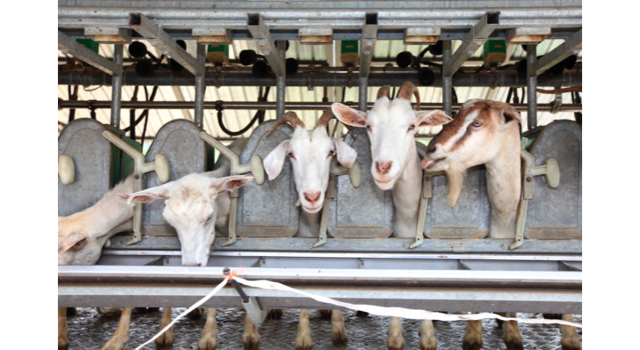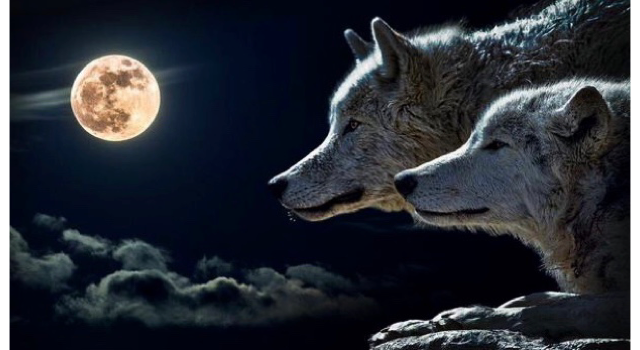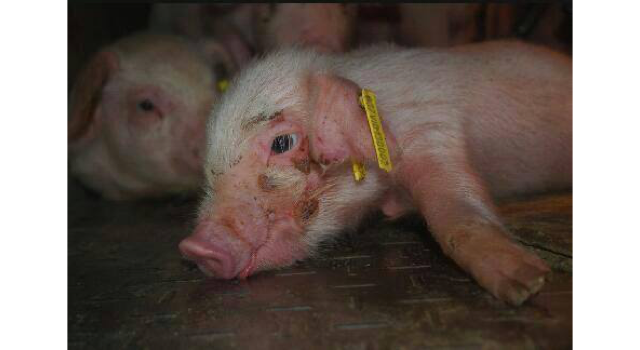Walrus In The Arctic Dies From Bird Flu. Researchers have confirmed the first known case…

Large-Scale Pig Farms In Germany Are Polluting Rivers And Lakes.
There is an old saying, rather unloved by local people, that if you roll down the window while driving through Germany, you’ll always know from the smell when you are in Lower Saxony.
This is the heartland of a €6billion pork industry that sends thousands of tonnes of German pig meat across the world.
But it has done so at a cost.
Maps of the Schweinegürtel (pig belt) glow a toxic red if you show ammonia emissions from farm animals and nitrates in groundwater.
Critics say local authorities in the region have allowed the industry to flourish while turning a blind eye to its environmental impact.
The sheer density of pigs in Lower Saxony is at the heart of the problem, explains Christine Chemnitz, director of the German agricultural think tank Agora Agriculture.
While animal manure is a source of agricultural fertiliser, overuse can lead to excess nitrates seeping into groundwater, where it can damage rivers, lakes and oceans.
Almost 60% of pigs in Germany are found in Lower Saxony and North Rhine-Westphalia, its neighbouring state to the south.
In some areas in Lower Saxony – home to more than 7 million pigs – the density of pigs is four times the national average.
In South Oldenburg, where many of Lower Saxony’s pig farms are located, ammonia levels were found to be more than twice the upper limit of those deemed environmentally safe.
But it is the nitrate issue that is the greatest environmental controversy in Lower Saxony.
The state has Germany’s highest proportion of “red areas’’ – where nitrates measure above the EU nitrate directive limit of 50mg/l.
The states of Lower Saxony and North Rhine-Westphalia are being sued by campaigners from Deutsche Umwelthilfe (Environmental Action Germany) for failing to tackle the issue.
They say two-thirds of the groundwater in the region around Lower Saxony’s Ems River has been left in a “desolate state”.
( Holly Young, 26.07.2022 ) Source: theguardian.com
Dairy Goats Face The Same Horrors As Dairy Cows.
A new undercover investigation by non-profit campaign group Animal Justice Project (AJP) has revealed the “violent killing” of baby goats at Pasture House Farm in North Yorkshire, England, UK.
Secret footage captured inside the intensive dairy — which holds more than 2,000 goats and churns out over a million litres of milk each year — also appears to show goats being slapped, shoved, grabbed and shouted at.
Pasture House Farm supplies award-winning dairy brand Delamere Dairy, which sells goat milk, butter, cheese and yogurt to major supermarkets including Tesco, Asda, Sainsbury’s, and Morrisons.
Delamere dairy farms in the U.K. reportedly account for around one-third of the country’s goat milk production.
According to its website, the company also operates in the U.S., Australia, China, Malaysia and Thailand.
Goat dairy is a popular choice among people who, for whatever reason, don’t consume cow’s milk.
But dairy goats face almost exactly the same plight as dairy cows.
In free-living populations, goat kids have been known to stay with their mothers for as long as eleven to twelve months.
But at Pasture House Farm, secret cameras filmed mother goats being taken away from their babies just hours after giving birth, a practice common to all dairy farms.
Following separation, the goats showed signs of distress such as searching for their kids and crying out.
Females are usually raised for use in the milking herd.
Estimates suggest that 25% to 50% of male goat kids born into the industry are killed.
The investigation is believed to be the first in the U.K. to film the killing of surplus baby goats.
The video shows newborn goats as young as one and two days old being shot with a stun gun before having a metal rod inserted into their forehead to end their life.
Other goats appear to be watching as this was carried out.
Distressing images show dead goats, including both kids and adults, dumped like waste in piles across the farm.
Goats have adapted to live in rugged, mountainous areas, where they would dig, climb, play and browse for food.
In contrast, goats at Pasture House Farm are held in large, crowded sheds with no enrichment and no access to the outdoors.
Goat dairy consumers may not realise that zero-grazing systems are the norm in goat farms.
Rather than being an isolated case of abuse, campaigners believe that Pasture House Farm is actually typical, “representative of commercial goat farming in the U.K.”
( Hannah McKay, 11.08.2022 ) Source: sentientmedia.org
Animal Suffering And Death Are Understood Only In Terms Of Profit And Loss.
Earlier this summer, 200,000 hens died in a massive fire at Forsman Farms, an egg farm in Wright County.
The birds trapped inside the barn suffered excruciating deaths, their flesh melting away as they frantically searched for a way out of their cages.
Tragic barn fires like this one are not uncommon.
A report released earlier this year estimates that more than 6 million farm animals died in barn fires between 2013 and 2021.
Barn fires are especially common in cold weather states, where heating devices can malfunction in winter.
Minnesota ranks among the top ten states for barn fire frequency.
According to a spokesperson for Forsman Farms, “No one was injured (in the fire).”
This thoughtless comment sheds light on the values of the animal farming industry today.
Animals are seen as commodities, not sentient individuals.
Animal suffering and death are understood only in terms of profit and loss.
A barn fire is a terrible way to die, but sadly, the entire lives of hens trapped inside factory farms are rife with suffering.
For most of these birds, life begins in an industrial hatchery.
Shortly after hatching under heat lamps, they travel down a conveyor belt to be “sexed.”
Male chicks, who have no use to the industry because they do not lay eggs, are tossed into a macerating machine where they are ground alive.
The surviving female chicks are sent to a dimly-lit grow-out barn, where they spend the next 16 weeks, until they are old enough to lay eggs.
Once mature, the hens move to a production barn.
Here, each hen spends her life producing eggs, permanently confined to a wire cage roughly the size of a standard sheet of paper – a space so small that she cannot even spread her wings.
At less than two years old, her egg production decreases, and she is sent to slaughter to be processed for low-grade meat.
( Julie Knopp, 12.08.2022 ) Source: minnpost.co
Pigs Die Kicking And Screaming And Writhing In Agony In Gas Chambers.
Industry chiefs and the Government were warned in 2003 the ‘best practice’ model for pig slaughter in the UK leaves the animals ‘kicking out and screaming’ before death after they are forced into ‘gas chambers’ and killed.
Supermarkets including Morrisons, Sainsbury’s and the Co-op continue to sell products advertising the highest standards of welfare for the animals, however, because of the way in which they die, this is misleading.
Those ‘highest standards’ leave the animals writhing in agony – fifteen years after a government committee pushed for a new method to be brought in.
Currently, between 70% and 90% of the nine million pigs slaughtered in the UK annually are ‘gassed’ with high co2 concentrations to stun them before they are killed for ‘meat’.
While supermarkets and meat companies advertise the pigs in organic products as having lived freely – they do not disclose on packaging the method used to kill them – which the government’s own advisory body called to be replaced in 2003.
For a killing to be truly humane it needs to be instant or non-aversive – and by that it means not causing panic, pain or distress.
High concentrations of CO2 gas causes fighting for breath, hyperventilation and pain for up to 60 seconds – sometimes longer.
The pigs begin to panic and kick out and try to escape.
They are gasping for air and screaming out.
They don’t want to die.
( Zoie O’Brien, 04.08.2018 ) Source: dailymail.co.uk
The Tragic Consequences Of Unchecked Oppression.
Each year, every one of us has the awesome power to spare 100 land and aquatic sentient beings just by choosing a diet that also happens to be better for our personal health and for the health of our planet.
Sadly, we don’t have that kind of power to save human victims of oppression.
The Holocaust has revealed the tragic consequences of unchecked oppression.
So does our continuing killing of animals for food.
When we drop animals from our menu, we take our very first step in fighting oppression.
( Alex Hershaft, 03.09.2020 )
The UK Government Break Their Promise And Continue To Murder Badgers.
Even though the UK Government promised in 2020 to replace killing badgers with cow and badger vaccine, improved cattle TB tests, and improved biosecurity measures on farms, under new licenses issued this summer, badgers will still be shot to death until 2025.
Evidence demonstrates that nine years of murdering badgers has not succeeded in reducing bovine TB in cattle.
Scientists, veterinarians, and naturalists are calling for a halt on the badger cull.
This summer marks the beginning of the tenth season of killing legally protected badgers to lessen cow TB, despite the fact that a scientific report published earlier this year in the journal Veterinary Record found that culling had little to no effect on the prevalence of bTB in cattle herds.
Experts who served on the government’s independent scientific panel examining the effectiveness and humaneness of culling, including Jane Goodall, Prof. Andrew Knight, and Prof. Ranald Munro, warned that new culling licenses could target 25,000 badgers in addition to the more than 175,000 killed under license since the contentious policy began in 2013.
( Patrick Barkham, 29.07.2022 ) Source: focusingonwildlife.com
The UK Government Allow Morons To Kill Thousands Of Wildlife Animals And Shoot Birds For Fun.
The grouse shooting season began on August 12 in the U.K.
Over a four-month season, red grouse are shot while taking flight after being flushed by beaters.
Though there is no comprehensive study to show an average killed yearly, one report states 700,000 were killed in one year alone.
Shooting predominantly takes place in the north of England and in Scotland on heather moorland.
Last year, Rewilding Britain reported that over 1,300 square miles of government-funded national parks in the U.K. are used for shooting, though another report estimates that the total usage of public and private land could exceed 5,000 square miles.
Unlike pheasants and partridges, which are largely imported from Europe and then reared in captivity, grouse are wild.
Red Grouse are ground-nesting birds, which makes their chicks and eggs vulnerable to predators.
As shooting estates intend to maintain a large and consistent population of birds to shoot, they carry out what is termed predation.
In reality, this means to trap and kill any wildlife that poses any threat to the rearing of game birds.
Though no study has been undertaken on grouse shooting estates in England, the findings of a field study revealed the scale of predation in Scotland and states that as many as 260,000 wild animals are trapped per year, half of which would be non-target species.
Snares, which are widely used, are described by campaigners as “cruel and indiscriminate” and have been documented catching domestic pets, farm animals and have been used to target legally protected species such as badgers and birds of prey.
In March 2020, Boris Johnson, U.K. prime minister at the time, announced a mandatory lockdown of the country due to the escalation of the COVID-19 pandemic.
Once confirmed cases of the virus lowered to a safer level, the “rule of six” was introduced which gave the public an opportunity to return somewhat to normality.
This new rule, however, wasn’t applicable for hunting as well as shooting, causing outrage after it was revealed that the prime minister accepted a hand-out worth £15,000 from David Ross, who owns two grouse shooting estates.
With such disregard for the environment and its inhabitants as well as lack of consideration for local communities, it is no surprise that people call for the shooting of red grouse to be banned.
( Aidan Frere-Smith, 29.08.2022 ) Source: sentientmedia.org
The UK Government Allow Farmers To Shoot And Kill Beavers.
The Tory Government will allow farmers in England, UK, to shoot and kill beavers if they threaten their crops.
Conservationists have opposed the move, saying the animals are an “ally to farmers”, helping conserve water in times of drought, and are an endangered species that should be treasured.
Beavers became extinct in the UK around 400 years ago after they were hunted for their pelts, but in recent years they have been reintroduced to England and Scotland.
After the wetland-creating creatures were found on the River Otter in Devon in 2013, the government allowed them to stay to test their impact on fish stocks and local landowners.
A study in 2019 found the beavers had enhanced biodiversity in the area and increased fish stocks.
Since then, the wheels have been set in motion for beavers to be recognised as a native English species and so be protected from harm.
From October 1, 2022, beavers in England will enjoy enhanced protection, paving the way for their re-population of the country’s waterways.
( Helena Horton and Gemma McSherry, 03.09.2022 ) Source: theguardian.com



This Post Has 0 Comments